Experience the Magic of Lanterns and History at Fuzimiao Qinhuai River
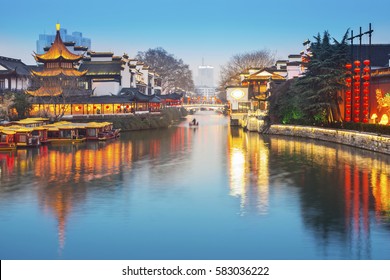
An Essential Guide to Visiting Fuzimiao Qinhuai River
Nestled in the heart of Nanjing, the Fuzimiao Qinhuai River area is a vibrant tapestry of history, culture, and breathtaking scenery. Imagine strolling along the banks of a river that has witnessed centuries of Chinese civilization, where traditional architecture meets the gentle glow of lanterns illuminating the night sky. The Confucian Temple Area, or Fuzimiao, stands as a testament to the enduring legacy of Confucius, with its majestic temple serving as a spiritual beacon and cultural hub.
This guide invites you to explore the essential experiences of the Fuzimiao Qinhuai River. From tranquil boat rides that offer a unique perspective of this historic landscape to bustling markets brimming with local handicrafts and delicious street food, there’s something for every traveler. Discover the best times to visit, must-see attractions, and insider tips for navigating the area like a local. Whether you’re a history enthusiast or simply seeking a picturesque escape, the Fuzimiao Qinhuai River promises an unforgettable journey into the heart of Nanjing’s rich cultural heritage.
In This Guide
- An Essential Guide to Visiting Fuzimiao Qinhuai River
- The Rich History and Legends of Fuzimiao Qinhuai River
- Main Highlights: What You Absolutely Can’t Miss
- Planning Your Visit: A Practical Guide
- Tickets: Prices, Booking, and Tips
- How to Get There: A Complete Transportation Guide
- Local Cuisine and Accommodation Nearby
- Frequently Asked Questions
- Final Thoughts on Your Trip
The Rich History and Legends of Fuzimiao Qinhuai River
A Journey Through Time: The History of Fuzimiao Qinhuai River
The Fuzimiao Qinhuai River, winding through the heart of Nanjing, is a living tapestry of history and culture. With roots that stretch back over a thousand years, this enchanting waterway has witnessed the rise and fall of dynasties, the flourishing of Confucianism, and the vibrant life of the city it nourishes.
The Birth of a Cultural Hub
In the 3rd century AD, during the Eastern Jin Dynasty, the Qinhuai River began to take shape as a vital artery for commerce and culture. Its banks quickly became a gathering place for scholars, poets, and artists, fostering a rich intellectual atmosphere. The river’s strategic location made it a hub for trade, linking Nanjing to other prosperous regions. As the city flourished, it attracted influential figures, including Confucian scholars who saw the potential for a center of learning and moral philosophy.
The Confucian Temple: A Beacon of Wisdom
The establishment of the Confucian Temple (Fuzimiao) in the 11th century during the Song Dynasty marked a pivotal moment in the river’s history. This temple, dedicated to Confucius, became a symbol of the city’s commitment to education and ethical governance. As students flocked to the area to study Confucian teachings, the river transformed into a vibrant cultural scene, dotted with academies, teahouses, and literary salons. The temple and its surrounding areas became a sanctuary of knowledge, fostering a legacy that endures to this day.
The Golden Age of the Qinhuai
The Ming and Qing Dynasties (14th to 20th centuries) were the golden age for the Qinhuai River. The riverbanks thrived with life as merchants sold their wares, and artists showcased their talents. The famous Qinhuai Lantern Festival, celebrated on the 15th day of the first lunar month, attracted visitors from far and wide, illuminating the night sky with colorful lights and festivities. This period also saw the rise of the “Qinhuai Eight,” a group of renowned poets and scholars whose works resonated throughout China, further embedding the river in the cultural consciousness.
A Canvas of Legends
The river is not just a backdrop for history; it is also steeped in enchanting legends. One of the most famous tales involves the beautiful courtesan, Li Xiangjun, who lived during the Ming Dynasty. It is said that her beauty was so captivating that even the moon would hide behind the clouds, envious of her charm. Legend has it that her spirit still wanders the banks of the Qinhuai, captivating visitors with ethereal beauty and grace. This story, along with many others, adds a layer of mystique to the river, making it a place where history and folklore intertwine.
Resilience Through Adversity
The 20th century brought tumultuous change to Nanjing, including the tragic events of the Nanjing Massacre during World War II. Despite the suffering, the river continued to flow, a testament to the resilience of the city and its people. Today, the Fuzimiao Qinhuai River stands not only as a reminder of the past but also as a symbol of hope and renewal, reflecting the enduring spirit of Nanjing.
A Living Legacy
Walking along the banks of the Fuzimiao Qinhuai River today, one can sense the echoes of history in the air. The vibrant markets, illuminated lanterns, and the soft sound of water lapping against the shore invite travelers to immerse themselves in the rich cultural heritage. As you explore this historic area, you’ll find that the river is more than a scenic waterway; it is a storyteller, weaving tales of wisdom, love, and resilience—a true reflection of Nanjing’s soul.
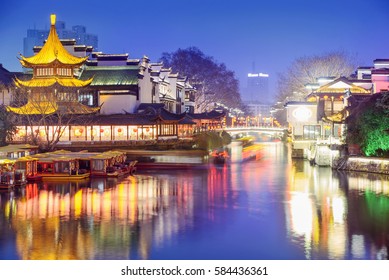
Fuzimiao Qinhuai River.
Main Highlights: What You Absolutely Can’t Miss
Confucius Temple (Fuzi Miao)
Step into the heart of Confucian philosophy at the majestic Confucius Temple, a stunning homage to the ancient Chinese scholar. The temple complex, with its intricate architecture and serene gardens, invites you to reflect on the teachings of Confucius. Don’t miss the chance to explore the stunning halls and pavilions, each adorned with inscriptions of his wisdom. For a truly memorable experience, visit in the early morning when the crowds are minimal, allowing you to soak in the tranquil atmosphere.
Qinhuai River
No visit to Fuzimiao is complete without a leisurely stroll along the picturesque Qinhuai River. This historic waterway, often referred to as the “Mother River” of Nanjing, is lined with vibrant lanterns and traditional wooden boats. As you walk along the riverbank, take in the stunning views of the shimmering water reflecting the colorful buildings. For an unforgettable experience, consider a night boat ride to witness the enchanting illuminations that dance on the surface of the river.
Confucius Temple Market
Indulge your senses at the bustling Confucius Temple Market, where local artisans and vendors showcase their crafts and delicacies. Here, you can find everything from traditional Chinese calligraphy to intricate jade carvings. Be sure to sample local snacks like “baozi” (steamed buns) and “jianbing” (Chinese crepes) while you shop. Arrive early to beat the crowds and ensure you have plenty of time to explore the myriad of stalls.
Nanjing Impressions Restaurant
For a taste of Nanjing’s culinary wonders, make your way to the Nanjing Impressions Restaurant, located just a stone’s throw from the Confucius Temple. Renowned for its authentic Jiangsu cuisine, this eatery is a food lover’s paradise. Don’t miss their specialty dishes, such as salted duck and the famous Nanjing-style dumplings. To avoid long wait times, consider making a reservation or visiting during off-peak hours.
Laomendong Historic Area
Venture a short distance from the Confucius Temple to the charming Laomendong Historic Area, where ancient architecture meets modern boutique shops. This lively neighborhood is filled with teahouses, art studios, and traditional inns. Take your time to wander the narrow alleyways, capturing the essence of old Nanjing. Late afternoons are ideal for a visit, as the area comes alive with street performances and local artisans showcasing their crafts.
Qinhuai Light Show
Make sure to catch the captivating Qinhuai Light Show, an extraordinary blend of light, color, and music that illuminates the river and its surroundings at night. The show typically runs from dusk until late evening, transforming the area into a magical spectacle. Settle onto one of the riverbanks with a local snack and enjoy the enchanting display as the historical buildings become canvases for breathtaking projections.
Xuanwu Lake
A short distance from the Fuzimiao area lies the tranquil Xuanwu Lake, a scenic escape from the bustling city center. Surrounded by lush gardens and ancient pagodas, this picturesque lake is perfect for a leisurely afternoon stroll or a peaceful boat ride. Bring a picnic to enjoy on the lakeside or rent a bike to explore the surrounding parklands. Early mornings or late afternoons are the best times to visit for stunning reflections of the surrounding scenery on the water.
With these highlights, your visit to Fuzimiao and the Qinhuai River will surely be an unforgettable adventure filled with culture, history, and delightful experiences!

Fuzimiao Qinhuai River.
Planning Your Visit: A Practical Guide
Best Time to Visit
The ideal time to visit Fuzimiao and the Qinhuai River is during the spring (March to May) and autumn (September to November) months. During these seasons, the weather is pleasantly mild, making it perfect for wandering through the bustling streets and enjoying the scenic views along the river. The area is particularly vibrant during festivals, such as the Lantern Festival in February, when beautiful lantern displays light up the night sky, creating a magical atmosphere.
Recommended Itinerary
Morning:
– Start your day at the Confucian Temple (Fuzimiao), exploring its architecture and engaging with the rich history of Confucianism.
– Stroll through the Confucius Temple Market, where you can find unique souvenirs and local handicrafts.
Afternoon:
– Enjoy a leisurely lunch at one of the local restaurants serving traditional Jiangsu cuisine, such as Nanjing salted duck.
– Take a scenic boat ride along the Qinhuai River, allowing you to appreciate the historical buildings and charming bridges from the water.
Evening:
– Return to Fuzimiao to experience the area illuminated at night, with its vibrant shops and restaurants.
– Don’t miss the Qinhuai Light Show, which offers a stunning visual display against the backdrop of the river.
Photography Tips
- Golden Hour: The best time for photography is during the golden hour, shortly after sunrise or before sunset. The soft lighting enhances the beauty of the temples and the river.
- Night Photography: Capture the magical ambiance of the area at night. Use a tripod for longer exposure shots to avoid blurriness with the lights.
- Focus on Details: Get close-up shots of the intricate carvings on the temple and the vibrant colors of the lanterns in the market.
- Reflections: Take photos of the buildings and lights reflected in the water, especially during the evening when the area is beautifully lit.
What to Wear
Dress comfortably for a day of exploration. Lightweight clothing is ideal for warmer months, while layers are recommended for cooler evenings. Comfortable walking shoes are a must, as you will be on your feet exploring the markets and temples. If you plan to take the boat ride, consider bringing a light jacket, as it can get breezy on the water.
Insider Tips
-
Explore Off the Beaten Path: While the main attractions are worth visiting, don’t hesitate to wander into the smaller alleys and side streets. You’ll find hidden tea houses and local eateries that offer a more authentic experience.
-
Street Food Adventure: Try local street food delicacies like Nanjing salted duck and pork dumplings from vendors. The night market is particularly lively and offers a variety of tasty treats.
-
Local Festivals: If your visit aligns with local festivals (like the Lantern Festival), you will experience traditional performances and celebrations, giving you a deeper insight into local culture.
-
Bargain Wisely: When shopping in the market, don’t hesitate to haggle for better prices. It’s a common practice, and you might score some great deals on souvenirs.
-
Boat Tours: Opt for a guided boat tour that provides historical context about the sights along the Qinhuai River. This can enhance your appreciation of the area’s rich history and culture.
Fuzimiao and the Qinhuai River offer a mesmerizing blend of history, culture, and vibrant street life. With this guide in hand, you’re set for an unforgettable visit to one of Nanjing’s most enchanting destinations.
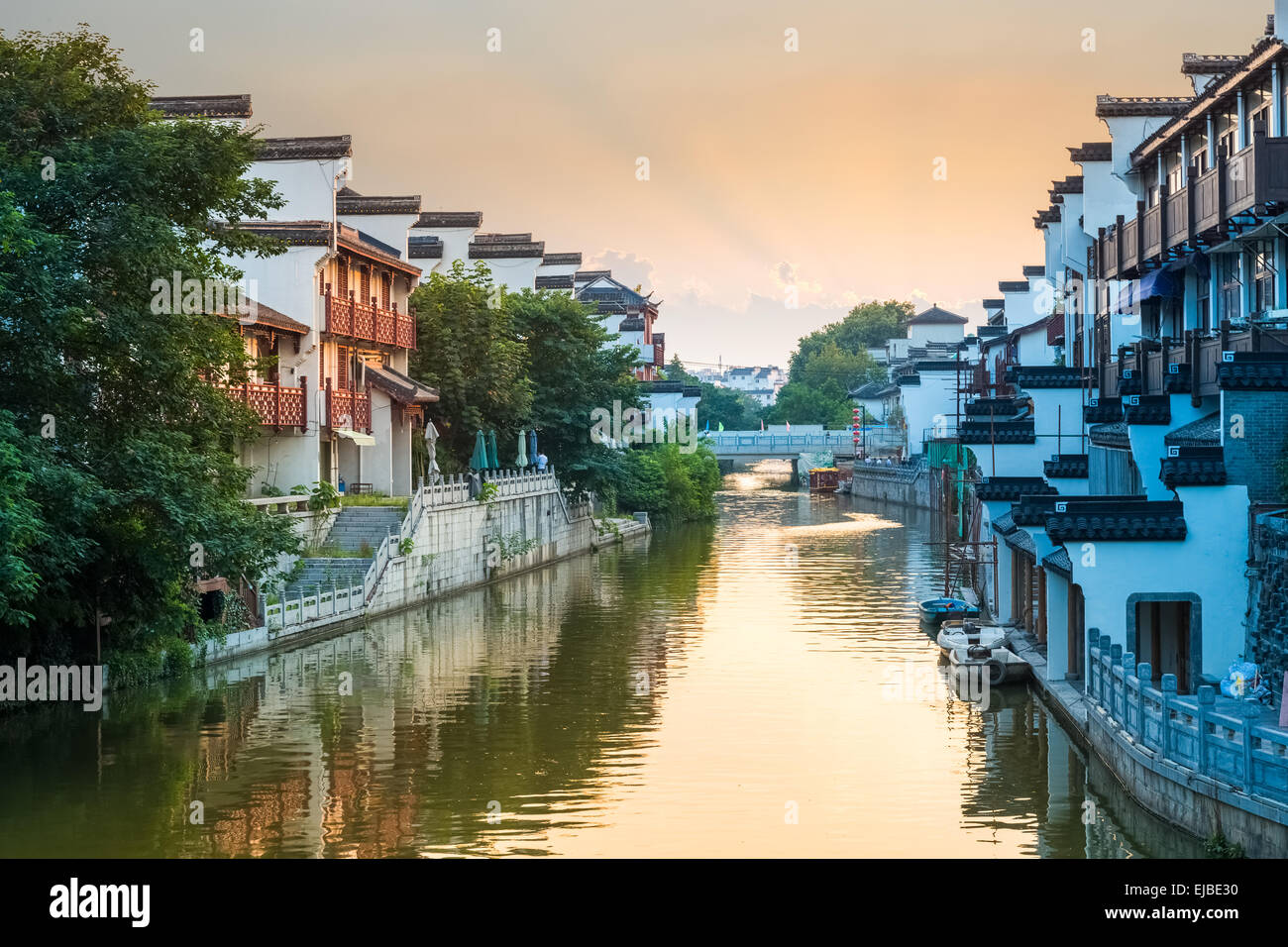
Fuzimiao Qinhuai River.
Tickets: Prices, Booking, and Tips
When planning your visit to the Fuzimiao Qinhuai River area, it’s essential to be informed about the various ticket options available. Below is a comprehensive overview to help you navigate your choices.
| Ticket Type | Price (CNY) | Includes |
|---|---|---|
| General Admission | 50 | Access to the Confucian Temple Area |
| Night Cruise | 120 | Scenic boat ride along the Qinhuai River, including views of illuminated temples and cultural performances |
| Guided Tour | 200 | Full-day guided exploration, including the Confucian Temple, local markets, and historical insights |
| Private Night Tour | 350 | Customized experience with a private guide, including dinner options and special evening activities |
Booking Information
Booking your tickets in advance is highly recommended, especially during peak travel seasons or holidays when the area sees a surge in visitors. Here’s how to secure your tickets:
-
Official Website: Visit the official website for the Confucian Temple Area and Qinhuai River to purchase tickets directly. This often provides the best prices and options.
-
Travel Agencies: Many reputable travel agencies offer ticket packages that include guided tours and additional experiences, making it a convenient option for international travelers.
-
Mobile Apps: Popular travel apps in China, such as Trip.com or Klook, allow for easy booking of tickets and tours, often with discounts.
-
In-Person: While you can buy tickets on-site, be prepared for potential long lines, especially during weekends and holidays.
By planning ahead and securing your tickets in advance, you can maximize your experience at the Fuzimiao Qinhuai River, ensuring a smooth and enjoyable visit to this cultural gem in Nanjing.
How to Get There: A Complete Transportation Guide
Accessing Fuzimiao Qinhuai River
Nestled in the heart of Nanjing, Fuzimiao Qinhuai River, or the Confucian Temple Area, is a captivating blend of culture, history, and scenic beauty. Getting there is relatively easy, thanks to Nanjing’s well-developed transportation network. This guide will provide you with detailed information on how to reach this enchanting destination from nearby cities and navigate the area once you arrive.
From the Nearest Major City: Nanjing
By Train:
Nanjing is well-connected by high-speed rail to several major cities in China, including Shanghai and Beijing. If you’re traveling from Shanghai, you can take a high-speed train from Shanghai Hongqiao Railway Station to Nanjing South Railway Station. The journey takes about 1.5 hours, and tickets range from CNY 150 to CNY 300 depending on the class. From Nanjing South Railway Station, you can take a taxi or the metro Line 1 to reach the Confucian Temple area.
- Train Schedule: Trains to Nanjing run frequently, approximately every 15-30 minutes.
By Bus:
Long-distance buses are also available from major cities. For example, from Shanghai, you can take a bus from Shanghai South Bus Station to Nanjing. The bus journey takes around 3–4 hours and costs approximately CNY 80 to CNY 120. Buses arrive at Nanjing’s Yangzhou Road Bus Station, from where you can take a taxi or local bus.
By Car:
If you prefer to drive, Nanjing is accessible via several expressways, including the G42 and G2501. The drive from Shanghai takes about 3 hours depending on traffic.
Getting to Fuzimiao Qinhuai River
Once in Nanjing, reaching Fuzimiao Qinhuai River is straightforward.
Metro:
The most efficient way to get to the Confucian Temple Area is via the metro. Take Line 1 and disembark at Fuzimiao Station. The temple area is just a short walk from the station and will take you around 5 minutes to reach.
Buses:
Several bus routes serve the Confucian Temple area. Routes 1, 3, 5, and 31 all stop near the entrance. Bus fares are very affordable, usually around CNY 2 per ride.
Taxi or Ride-Sharing Services:
Taxis are widely available in Nanjing. A ride from the city center to Fuzimiao will typically cost between CNY 15 and CNY 30, depending on your starting point. Ride-sharing apps like Didi are also operational and can be a convenient option.
Getting Around the Scenic Area
Once you arrive at Fuzimiao Qinhuai River, exploring the area is a delight. Here are some tips for getting around:
Walking:
The Confucian Temple area is pedestrian-friendly, with many attractions within walking distance. Stroll along the Qinhuai River, visit the Confucius Temple, and explore the labyrinth of shops and food stalls that line the streets.
Boats:
Consider taking a scenic boat ride along the Qinhuai River. Various boat services operate in the area, providing a unique perspective of the temple and surrounding architecture. Prices for boat rides typically range from CNY 50 to CNY 100, depending on the duration and type of cruise.
Bicycles:
Bike rentals are available for those who wish to explore at their own pace. You can find bike-sharing services through local apps, and costs are usually around CNY 1–2 per hour.
Guided Tours:
For a more in-depth experience, consider joining a guided tour. Many local companies offer private and group tours that include transportation and an expert guide who can share insights into the history and culture of the area.
With this comprehensive transportation guide, you’re well-equipped to embark on your journey to Fuzimiao Qinhuai River. Enjoy the rich cultural tapestry of Nanjing, and make memories that will last a lifetime!
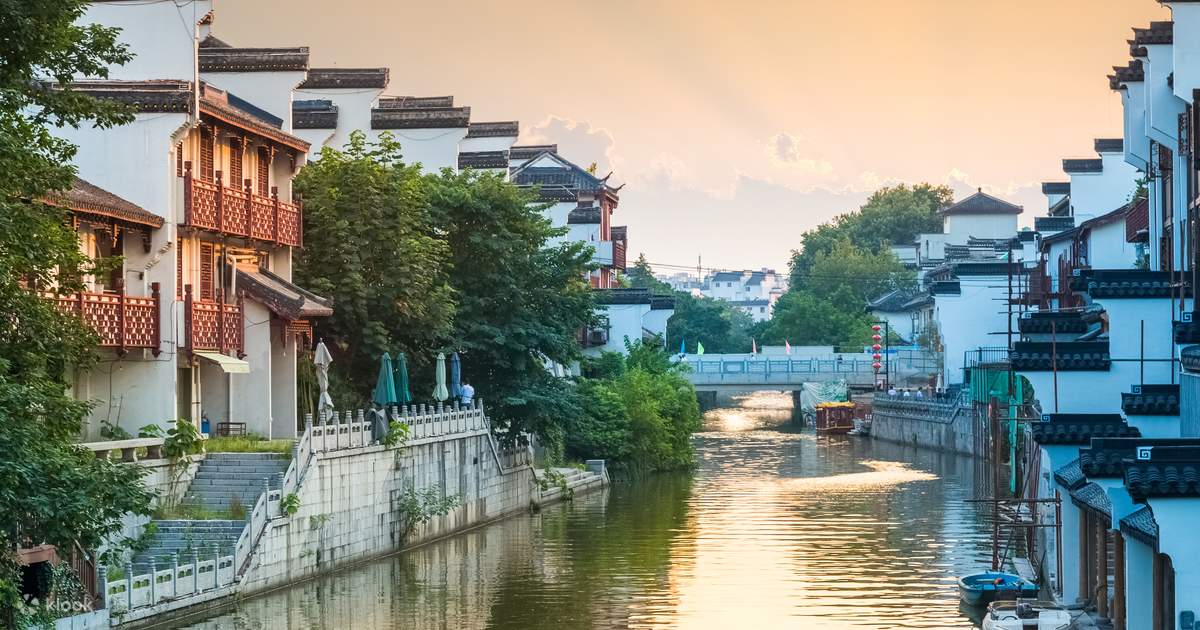
Fuzimiao Qinhuai River.
Local Cuisine and Accommodation Nearby
When exploring the vibrant surroundings of Fuzimiao (Confucian Temple) and the picturesque Qinhuai River, indulging in the local cuisine is a must. Nanjing offers a delightful array of dishes that reflect its rich culinary heritage. Here are a few local specialties to tantalize your taste buds:
Local Delicacies
-
Nanjing Salted Duck (盐水鸭)
This iconic dish features tender duck marinated in a blend of salt, spices, and aromatic herbs. The result is a succulent and flavorful dish that is often served cold, making it a refreshing choice for warm weather. -
Duck Blood Soup (鸭血粉丝汤)
A comforting bowl of soup made with duck blood, vermicelli noodles, and tofu, this dish is a local favorite. The broth is rich and savory, often enhanced with spices and herbs, providing a hearty meal that warms the soul. -
Jiangsu-style Dumplings (江苏汤包)
These steamed dumplings are filled with a savory mixture of meat and broth, offering a delightful burst of flavor with every bite. They are typically served with a side of vinegar and ginger for dipping. -
Sticky Rice Rolls (粽子)
A traditional treat, these sticky rice rolls are filled with various ingredients such as red bean paste, meat, or vegetables, and wrapped in bamboo leaves before being steamed. They make for a sweet or savory snack that pairs perfectly with tea.
Accommodation Options
Whether you’re seeking luxury or a cozy boutique experience, there are several accommodation choices near Fuzimiao that cater to various tastes and budgets.
-
Luxury: InterContinental Nanjing
Overlooking the Yangtze River, this five-star hotel offers opulent rooms with stunning views, an exquisite spa, and gourmet dining options. It’s an ideal choice for travelers who seek top-tier amenities and service. -
Boutique: The Eighth Day Hotel
Nestled in the heart of Nanjing, this stylish boutique hotel features uniquely designed rooms that blend modern comforts with local decor. Guests can enjoy personalized service and a cozy atmosphere, making it a lovely retreat after a day of exploration. -
Budget: Nanjing Impressions (Fuzi Miao Shuipingfang)
Offering a comfortable stay at an affordable price, this hotel is just a short walk from the Confucian Temple. With clean rooms and friendly staff, it’s perfect for travelers looking for value without sacrificing quality. -
Hostel: Nanjing Dreamer Youth Hostel
For those on a tighter budget or seeking a social atmosphere, this hostel provides a lively setting, with dormitory-style accommodations and private rooms. It’s a great place to meet fellow travelers and share stories after a day of adventures.
With its rich culinary landscape and diverse accommodation options, the Fuzimiao Qinhuai River area promises an unforgettable experience for international travelers eager to immerse themselves in Nanjing’s culture.
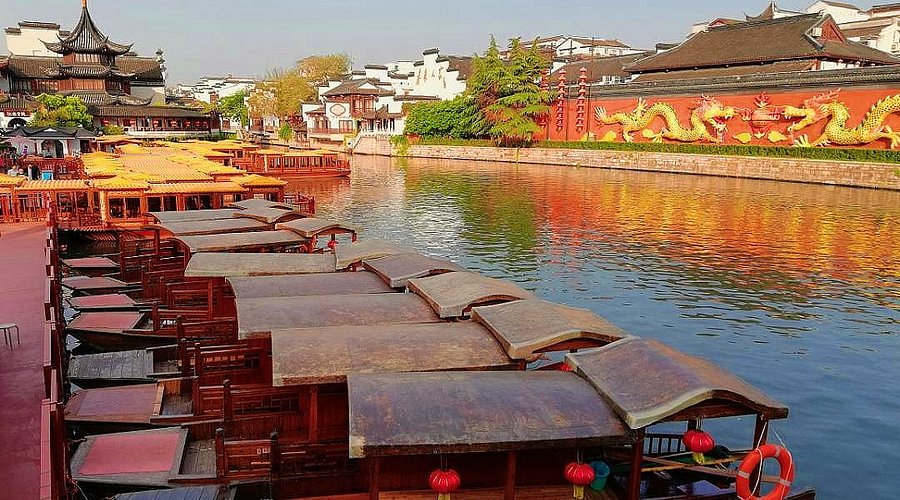
Fuzimiao Qinhuai River.
Frequently Asked Questions
Frequently Asked Questions about Fuzimiao Qinhuai River
-
Is Fuzimiao Qinhuai River suitable for children and the elderly?
Yes, the Fuzimiao Qinhuai River area is family-friendly and accessible for both children and the elderly. There are paved paths and plenty of seating areas, making it easy for everyone to explore and enjoy the scenery. However, be mindful of potential crowds, especially during weekends and holidays. -
Are there English signs available?
While Chinese is the primary language, many signs in and around the Fuzimiao Qinhuai River area include English translations, especially in tourist-focused locations like the Confucian Temple and nearby shops. However, it may be helpful to have a translation app handy for lesser-known areas. -
How much time should I plan to spend at Fuzimiao Qinhuai River?
Plan to spend at least 2 to 4 hours exploring the Fuzimiao Qinhuai River area. This allows time to visit the Confucian Temple, stroll along the river, enjoy local snacks, and shop for souvenirs. If you’re interested in a night visit for the light shows and performances, consider extending your stay. -
What is the best time to visit Fuzimiao Qinhuai River?
The best time to visit is in the late afternoon or evening. The area is beautifully illuminated at night, with vibrant lights and lively performances. Visiting during the spring and autumn months is also ideal due to the pleasant weather. -
Are there food options available nearby?
Absolutely! The Fuzimiao Qinhuai River area offers a variety of dining options, from street food stalls selling local delicacies to sit-down restaurants. Be sure to try traditional Nanjing snacks such as salted duck and dumplings for a true culinary experience. -
Is there an entrance fee to visit the Confucian Temple within the area?
Yes, there is a nominal entrance fee for the Confucian Temple. Prices may vary, so it’s a good idea to check in advance. However, exploring the surrounding areas along the river is free. -
What transportation options are available to get there?
Fuzimiao Qinhuai River is easily accessible via public transportation, including buses and the metro. Taxis and ride-hailing services are also convenient options. If you prefer to walk, the river is centrally located and can be reached from many parts of Nanjing. -
Are there guided tours available?
Yes, there are numerous guided tours available that focus on the Fuzimiao Qinhuai River and its surrounding attractions. These tours often include the Confucian Temple, local markets, and food experiences, providing a more in-depth understanding of the area’s culture and history. Booking in advance is recommended, especially during peak tourist seasons.
Final Thoughts on Your Trip
As your journey through the enchanting Fuzimiao Qinhuai River comes to a close, take a moment to reflect on the rich tapestry of experiences that this historical area has woven for you. From the tranquil beauty of the riverbanks to the vibrant hustle and bustle of the Confucian Temple Area, every corner invites you to delve deeper into the philosophy and culture that have shaped Nanjing over centuries.
Whether you’ve marveled at the intricate architecture, enjoyed the dazzling night illuminations, or savored the local delicacies amidst a labyrinth of shops, each moment here is a brushstroke on the canvas of your travels. The echoes of Confucian wisdom resonate in the air, reminding us of the importance of knowledge, respect, and harmony in life.
As you leave this serene yet lively enclave behind, carry with you the spirit of discovery and appreciation for the rich history that surrounds us. May your adventures continue to inspire and enrich your life, just as the waters of the Qinhuai have nourished the soul of Nanjing for generations. Safe travels and may your next destination be just as captivating!